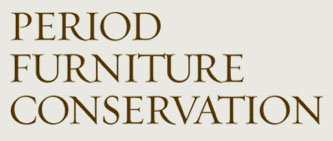AUTUMN 2013 ___________________________ In the Studio: What Wood Is That? 
When
I first went to California for graduate studies after growing up in the industrial Midwest, I was struck by the breathtaking natural vistas. I very much enjoyed hiking in the region, although I never fulfilled my intention to visit the White Mountains and see the bristlecone pines, Pinus longaeva. These readily identifiable trees are among the oldest known species still extant. Some specimens are believed to be over 5,000 years old — more ancient than many civilizations.
Today,
the identification of old woods is part of everyday life in the studio. Unlike the living bristlecones, which provide ample evidence of their identity, the examples we see in the studio can be much more difficult to recognize with certainty. Recently we were asked to conserve a beautiful and intricate parquetry panel whose design featured many different veneers. Since there were a few missing sections, we examined the veneers that were still in situ to determine appropriate matches for replacement.
History, Theory and Practice
Identification of trees started with Theophrastus, the ancient Greek "father of botany." Relying on first hand observation, he grouped plants according to their form of growth, such as trees or shrubs, their localities, sizes, use, and cultivation. In the 18th century, Linnaeus introduced the concept of genus and species, organizing plants systematically by number and arrangement of
their sexual organs and publishing his framework in the still-influential Species Plantarum.
Another body of literature has grown up around wood morphology. Romeyn Beck Hough's 15-volume The American Woods (1888) included actual veneer plates. The International Association of Wood Anatomists (IAWA, http://www.iawa-website.org), founded in 1931, compiled a listing of 163 anatomical and 57 non-anatomical features to assist in identifying hardwoods. North Carolina State University has created a searchable online database based on IAWA characteristics and illustrated with photomicrographs (http://insidewood.lib.ncsu.edu). The largest reference collection of actual wood samples is maintained at the Center for Wood Anatomy and Research at the USDA's Forest Products Laboratory in Madison, WI, which has a collection of over 100,000 samples.
In spite of this extensive body of literature and samples, identifying harvested wood remains a challenging task. While many of the gross features are recognizable under a hand lens, a stereo, compound or digital microscope may be needed for more positive identification. To complicate matters, the examiner must consider specimens from three views: transverse, radial or tangential. Each view corresponds to the way a wood worker would cut a log: cross-cut, quarter sawn and plain sawn.
When conserving historic objects, this form of analysis is usually reserved for authentication purposes, since taking specimens — even small slivers — is a destructive form of testing. So an extensive collection of solid woods, veneers and reference books is invaluable in our work.
Conservation Issues
Back to our parquetry panel, the challenge we faced was how to correctly identify the light tan and black woods of a beautiful, diagonally cut banding inlay, only three-sixteenth of an inch in width, so that we could make up duplicates for replacement (see lefthand image). Adopting the least invasive approach, we decided to forgo destructive testing, and relied on a visual comparison of the original with my firm's extensive reference wood sample collection and focusing primarily on grain pattern. Color is a less reliable characteristic, since objects are frequently stained, given a tinted coating or blanched by sunlight exposure. Using visual trial and error we determined that the light tan wood was pear, based on the very tight and even grain, lack of color variation, and a small section of fresh wood that was exposed due to previous damage.
The greater challenge was the black colored wood, which we initially assumed to be a species of ebony. Ebony is part of the Diospyros genus and is found in many parts of the world, including India, western Africa and Indonesia. The species vary tremendously in terms of subtle figure, grain and evenness of
color. In all cases, however, it is dense and the blackest grades tend to be very brittle. Our original black inlay was interesting
since it was extremely small, and very even in its blackness with no grain showing. We initially considered Diospyros
dento, Gabon ebony, but experienced difficulty in fabricating such small sections, which splintered easily. Re-examining the inlay, we realized it had no fabrication imperfections. This pointed us in
another direction, and to another genus. We focused on African blackwood, Dalbergia melanoxylon, an equally uniformly black, though much denser and less brittle wood. This characteristic — density, or more accurately, specific gravity — is one of IAWA's 57 non-anatomical features When reflected in a wood's working properties, it pointed us to the correct identification. Our new test samples were now much more successful, and the replacements are imperceptible from the original
______________________________________________
Co-Presenter: In May of 2013, Yuri Yanchyshyn and Alexandra Darraby of the Art Law Firm (www.artlawfirm.com) spoke at the Annual Meeting of the American Institute for Conservation on the topic of "21st Century Art, Design, & Conservation: Protected Materials and Fine Arts Conservation". This presentation focused the implications of endangered species materials as found in art objects, both from a conservation and law perspective. Yuri frequently speaks on topical issues. To invite him to speak to your group - email _______________________________________________
Furniture Conservator Yuri Yanchyshyn has worked with wooden objects for over 30 years, from a cabinet-maker's shop to the laboratories of The Metropolitan Museum of Art. Private collectors, museums, architects and designers have all entrusted precious items from the 14th through the 20th centuries to Yuri's care, and institutions such as Institute of Fine Arts Conservation Center invite him to lecture. Yuri holds degrees from the University of Michigan and the California Institute of the Arts and received advanced training from the Amsterdam Academy for Restoration and the Smithsonian Center for Materials Research and Education.
(c) 2013 Period Furniture Conservation LLC. All rights reserved. |











